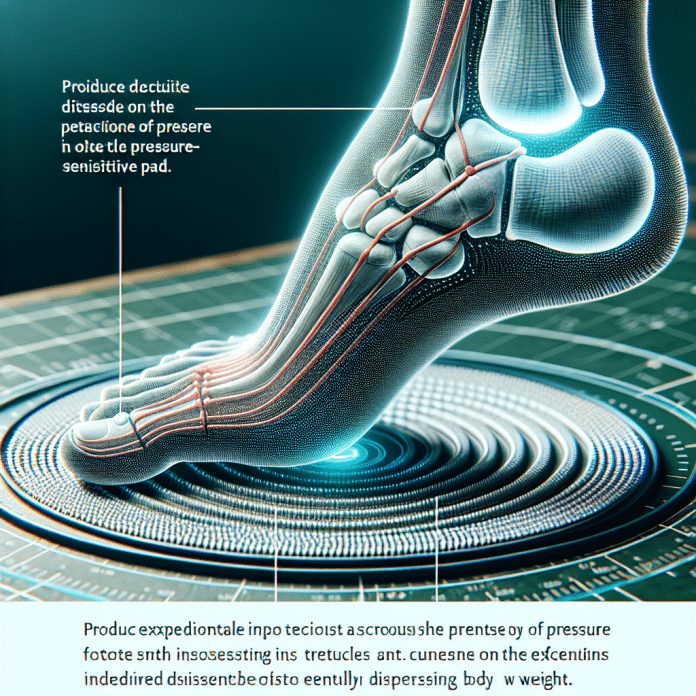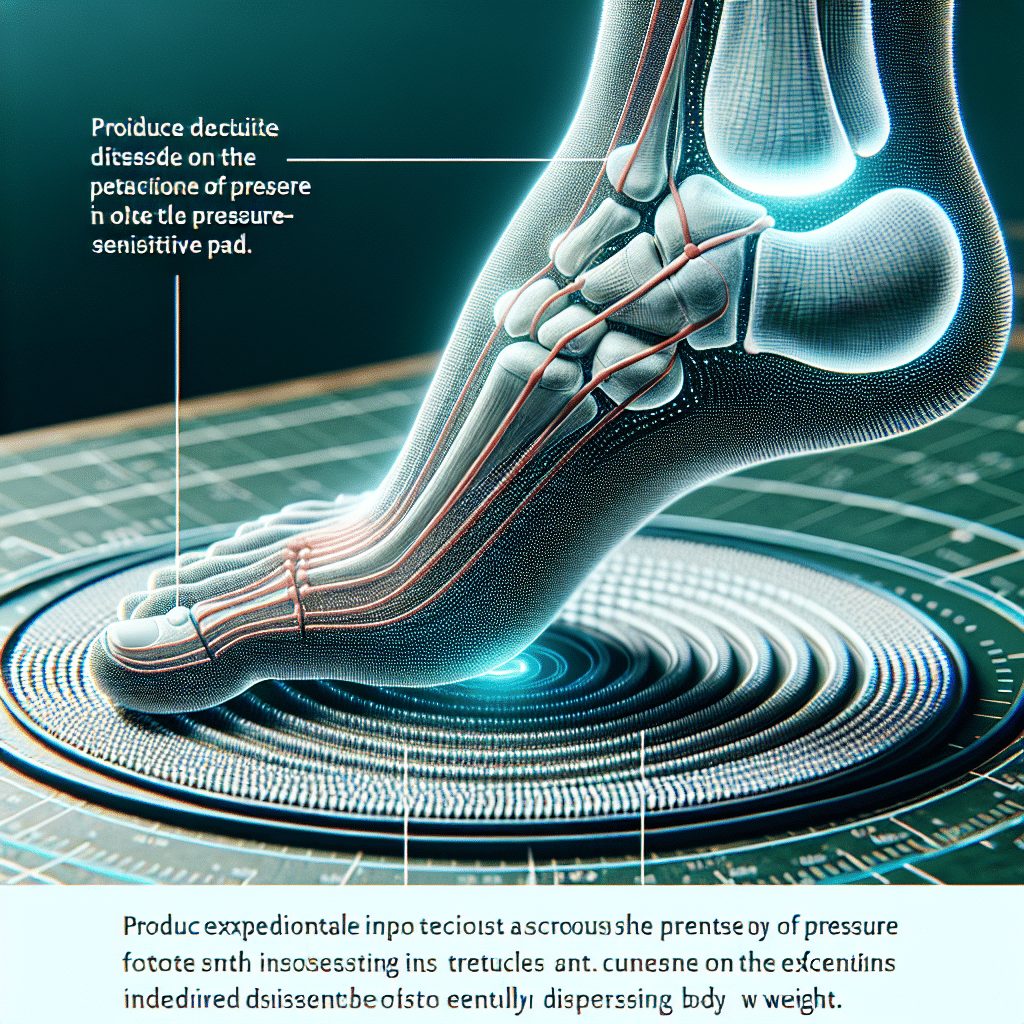Have you ever wondered how insoles work to evenly distribute your body weight across your feet? In this article, we will explore the fascinating mechanics behind these seemingly simple inserts. By understanding the science behind insoles, you can not only alleviate foot discomfort but also improve your overall posture and balance. So let’s delve into the world of insoles and discover how they help in distributing body weight evenly across your feet.
Anatomy of the Feet
Structure of the Feet
The feet are a complex structure comprised of bones, muscles, ligaments, and tendons, all working together to support the body and facilitate movement. Each foot consists of three main sections: the forefoot, midfoot, and hindfoot. The forefoot contains the toes and metatarsal bones, while the midfoot contains the arch and tarsal bones. The hindfoot consists of the heel and ankle. These structures are all interconnected, allowing the feet to adapt to different surfaces and absorb impacts during weight-bearing activities.
Function of the Feet
The feet play a crucial role in maintaining balance, stability, and mobility. They act as shock absorbers, cushioning the body from the impact of walking, running, or jumping. The muscles and ligaments within the feet work together to support the arches, provide propulsion, and maintain proper alignment. Additionally, the feet contain numerous proprioceptors, sensory receptors that provide feedback to the brain about body position and movement. This feedback helps with balance and coordination.
Importance of Weight Distribution
Effects of Improper Weight Distribution
When the weight is not evenly distributed across the feet, it can lead to various foot problems and discomfort. Uneven weight distribution can cause excessive pressure on certain areas of the feet, leading to the formation of calluses, corns, and bunions. It can also result in foot and leg fatigue, as well as muscle imbalances throughout the lower body. Furthermore, improper weight distribution can lead to gait abnormalities and contribute to postural issues and back pain.
Benefits of Even Weight Distribution
Achieving even weight distribution across the feet is essential for maintaining proper foot function and overall body alignment. When weight is evenly distributed, the feet are better able to absorb shock and impact, reducing the strain on joints and preventing overuse injuries. Even weight distribution can also help alleviate foot pain and improve stability, allowing for a more efficient and comfortable gait pattern. By evenly distributing weight, the feet can function optimally and prevent the development of any potential foot conditions.
Role of Insoles
Definition and Purpose of Insoles
Insoles, also known as shoe inserts or footbeds, are designed to provide additional support, cushioning, and stability to the feet. They are placed inside footwear and come in various shapes, sizes, and materials. The primary purpose of insoles is to enhance comfort, alleviate foot pain, and correct biomechanical imbalances. They can help address issues related to arch support, cushioning, shock absorption, and proper weight distribution. Insoles can be used for general foot health and prevention or as a treatment for specific foot conditions.
Different Types of Insoles
There are several types of insoles available to cater to different foot needs and conditions. Arch support insoles are designed to provide support and stability to the arches of the feet, helping to alleviate flat feet or fallen arches. Cushioned insoles offer additional padding and shock absorption for those who require extra comfort. Orthotic insoles are custom-made inserts that are specifically tailored to an individual’s foot anatomy and can address specific foot conditions. Additionally, there are gel insoles, memory foam insoles, and even insoles with metatarsal pads, each offering unique benefits catered to individual needs.
Mechanism of Weight Distribution
Pressure Points on the Feet
The feet have specific pressure points where the weight is concentrated during standing, walking, or running. These pressure points are located primarily at the heels, balls of the feet, and the arches. In a healthy foot, weight is distributed evenly across these pressure points, allowing for efficient weight-bearing and shock absorption. However, if there is an imbalance or misalignment in the feet or if certain areas bear more weight than others, it can lead to excessive pressure and discomfort.
Pressure Redistribution by Insoles
Insoles play a crucial role in redistributing body weight across the feet. They achieve this by providing additional support to the arches, cushioning impact, and promoting proper alignment. Arch support insoles help distribute weight evenly across the arches, preventing the collapse of the arch and relieving pressure on other areas of the foot. Cushioned insoles absorb shock and reduce the impact on the pressure points, ensuring that weight is evenly distributed. By redistributing pressure, insoles help alleviate pain, prevent foot conditions, and promote overall foot health.
Impact of Arch Support
Understanding the Arch of the Foot
The arch of the foot refers to the curved shape formed by the bones and soft tissues that span from the heel to the ball of the foot. There are three main types of arches: flat, neutral, and high. Flat arches have minimal curvature, while neutral arches have a moderate curve, and high arches have an exaggerated curve. The arch acts as a natural shock absorber, helping to distribute weight evenly across the feet during movement.
Benefits of Proper Arch Support
Proper arch support is essential for maintaining foot stability, preventing overpronation or supination, and providing adequate shock absorption. Insoles with arch support can help realign the foot structure, reducing the risk of foot pain and foot conditions associated with imbalances. Arch support insoles help distribute weight evenly across the arches, ensuring that excessive pressure is not concentrated in one area. They also help improve balance, decrease fatigue, and provide overall comfort during weight-bearing activities.
Cushioning and Shock Absorption
Importance of Cushioning
Cushioning is vital for reducing the impact and stress exerted on the feet during various activities. Insufficient cushioning can lead to discomfort, pain, and the development of foot conditions such as plantar fasciitis or heel spurs. Cushioned insoles provide an additional layer of padding, absorbing shock and minimizing the forces transmitted to the feet and lower limbs. By cushioning the feet, insoles help alleviate pressure and provide enhanced comfort, especially for individuals with sensitive or arthritic feet.
How Insoles Absorb Shock
Insoles with shock-absorbing properties are designed to dissipate the energy generated from each step and reduce the impact on the feet and joints. These insoles often utilize materials such as gel, foam, or air chambers to absorb and disperse the shock forces. As the feet make contact with the ground, the shock-absorbing insoles compress, minimizing the stress on the feet and reducing the risk of repetitive strain injuries. By absorbing shock, insoles prevent excessive pressure on the feet and help maintain proper weight distribution.
Alignment and Stability
Maintaining Proper Alignment
Proper alignment of the feet is crucial for maintaining overall body alignment and preventing injuries. Misalignment can lead to foot pronation (rolling inward) or supination (rolling outward), affecting the distribution of weight and the biomechanics of the lower extremities. Insoles can help correct misalignment issues by providing support and stability. Arch support insoles help realign the foot structure, preventing excessive pronation and promoting a more neutral position. This proper alignment allows for even weight distribution, reduces stress on the joints, and improves overall body posture.
Enhancing Stability
Stability is essential for maintaining balance and preventing falls or injuries. Insoles can enhance stability by providing additional support and cushioning to the feet. Cushioned insoles help reduce foot fatigue and improve stability by minimizing the impact forces and vibrations transmitted to the body. By providing a stable base, insoles help individuals maintain better control and balance during various activities, reducing the risk of ankle sprains or other instability-related injuries.
Customization and Personalization
Getting the Right Fit
Insoles should be chosen based on an individual’s specific foot shape, arch type, and personal needs. It is important to consider factors such as foot length, width, and arch height when selecting insoles. Insoles that fit properly ensure maximum support, comfort, and effectiveness. To find the right fit, it is recommended to try on different sizes and styles of insoles and test them in the shoes you wear most frequently. Customizing the fit can greatly optimize the benefits and functionality of the insoles.
Custom-Made Insoles
For individuals with specific foot conditions or complex biomechanical issues, custom-made insoles may be necessary. These insoles are created based on an individual’s foot measurements, arch type, and any specific requirements. Custom-made insoles provide the highest level of customization and personalization, ensuring a perfect fit and addressing specific foot concerns. They are often prescribed by healthcare professionals for individuals with conditions such as plantar fasciitis, diabetic foot, or severe pronation issues.
Considerations for Different Foot Conditions
Flat Feet
Flat feet, or fallen arches, occur when the arches collapse and the entire sole of the foot comes into contact with the ground. In this condition, weight distribution is uneven, and excessive pressure can be exerted on certain areas of the foot. Insoles with arch support are particularly beneficial for individuals with flat feet as they help to lift and support the arches, redistributing weight and alleviating discomfort.
High Arches
High arches occur when there is an excessive curve in the arch of the foot. This can result in poor shock absorption, increased pressure on the ball and heel, and instability. Insoles with added cushioning and arch support can help improve weight distribution and provide extra shock absorption for individuals with high arches. These insoles help to minimize discomfort and promote proper alignment.
Plantar Fasciitis
Plantar fasciitis is a common condition characterized by inflammation of the plantar fascia, a thick band of tissue that connects the heel to the toes. It causes heel pain and discomfort, particularly in the morning or after periods of rest. Insoles designed specifically for plantar fasciitis often include extra arch support and cushioning in the heel area. These insoles help reduce strain on the plantar fascia, provide shock absorption, and alleviate pain associated with the condition.
Diabetic Foot
Individuals with diabetes often experience poor circulation and nerve damage in the feet, making them prone to foot ulcers and injuries. Insoles for diabetic foot conditions focus on providing cushioning, pressure relief, and proper weight distribution. These insoles are designed to reduce friction, absorb shock, and minimize pressure on sensitive areas, helping prevent complications and ensuring optimal foot health for individuals with diabetes.
Choosing the Right Insoles
Foot Type and Pronation
When selecting insoles, it is important to consider your foot type and degree of pronation. Foot pronation refers to how the foot rolls inward or outward during movement. Overpronation occurs when the foot rolls excessively inward, while supination occurs when the foot rolls excessively outward. Insoles with appropriate arch support and stability features can help correct these pronation issues and promote proper alignment and weight distribution.
Activity Level and Footwear
The type of physical activity you engage in and the footwear you use play a significant role in choosing the right insoles. High-impact activities such as running or jumping require insoles with good shock absorption properties, while activities that involve prolonged standing or walking may benefit from insoles that offer additional cushioning and support. It is important to select insoles that are compatible with your footwear, ensuring they fit properly and do not alter the fit or function of your shoes.
In conclusion, understanding the anatomy of the feet, the importance of weight distribution, and the role of insoles is key to achieving optimal foot health and function. Insoles can help redistribute weight, provide arch support, enhance cushioning and shock absorption, improve alignment and stability, and cater to different foot conditions. By choosing the right insoles and addressing individual needs, you can ensure that your feet remain comfortable, supported, and well-aligned, allowing you to move with ease and enjoy an active, pain-free lifestyle.









































